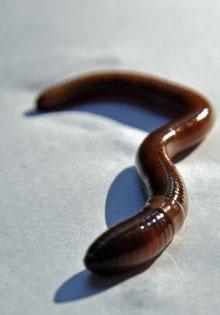A worm with a lot of body English might be good for fishing, but when it's an uninvited pest introduced to the forest duff of Great Smoky Mountains National Park, well, it's just bad news.
The worm in hand is known as the Asian jumping worm (Amynthas agrestis), a relatively unobtrusive earthworm whose claim to fame is its ability to fling itself more than a few inches. Its other claim to fame is more troublesome -- it has got quite an appetite, and in the national park it stands poised to deprive the natives of more than a few leafy meals, according to park officials.
Composting ads boast that the worm can eat and process more than its body weight in organic matter (vegetable scraps, leaves, lawn trimmings, etc.) each day. That same tenacious appetite means that when people release their bait (or their bait escapes) and the worms make their way to the forest, they consume massive amounts of leaf litter. If you were a leaf-litter-feeder such as a millipede, fly larvae, or springtail, this would be a big problem because your food source would be gone! It would also be bad if you were a creature that ate these invertebrates. In some areas on the western side of the Smokies, the Jumping Worm population is so high there is almost no leaf litter left. Without this food, native animals are disappearing, and the nutrients from decaying plants aren’t there to build new soil!
The worms, whose ancestors likely reached the United States a century or more ago in the root balls of imported plants, have been in the park at least three years. Odds are that anglers introduced the worms into the Smokies via their bait buckets (even though live bait it not allowed in Great Smoky's waters).
Now two Austrian researchers, Anita Juen and Daniela Straube from the University of Innsbruck, are taking a closer look at just what these worms might be doing to the park’s food web, and to see if predators change their diet to eat the invasive earthworms.
Can you imagine the tussle a robin might find itself in for?




Comments
You can buy these worms ... called Alabama Jumpers ... on-line for fishing and worm composting. http://alabamajumpers.com/.
Importing animals & plants of ANY kind from outside of the U.S. & Canada should be illegal or at least require permitting after full study of what such species can do to our environment. Invasive species are a serious problem not only for ecosystems but even for farming, fishing, hunting, & logging.
Problem is, like the Asian carp, the cat's out of the bag, virtually nothing to do about it now.
Actually, Barky, I believe importing any foreign organism without a permit is a violation of federal law. Unfortunately it's nearly impossible to enforce because of the sheer voume of pests being carted accross our borders and into our ports.
Henry, I'm pretty sure they only ban what they believe is harmful, not only allow what they know is safe. California has a harder line I think. Not my area of expertise.